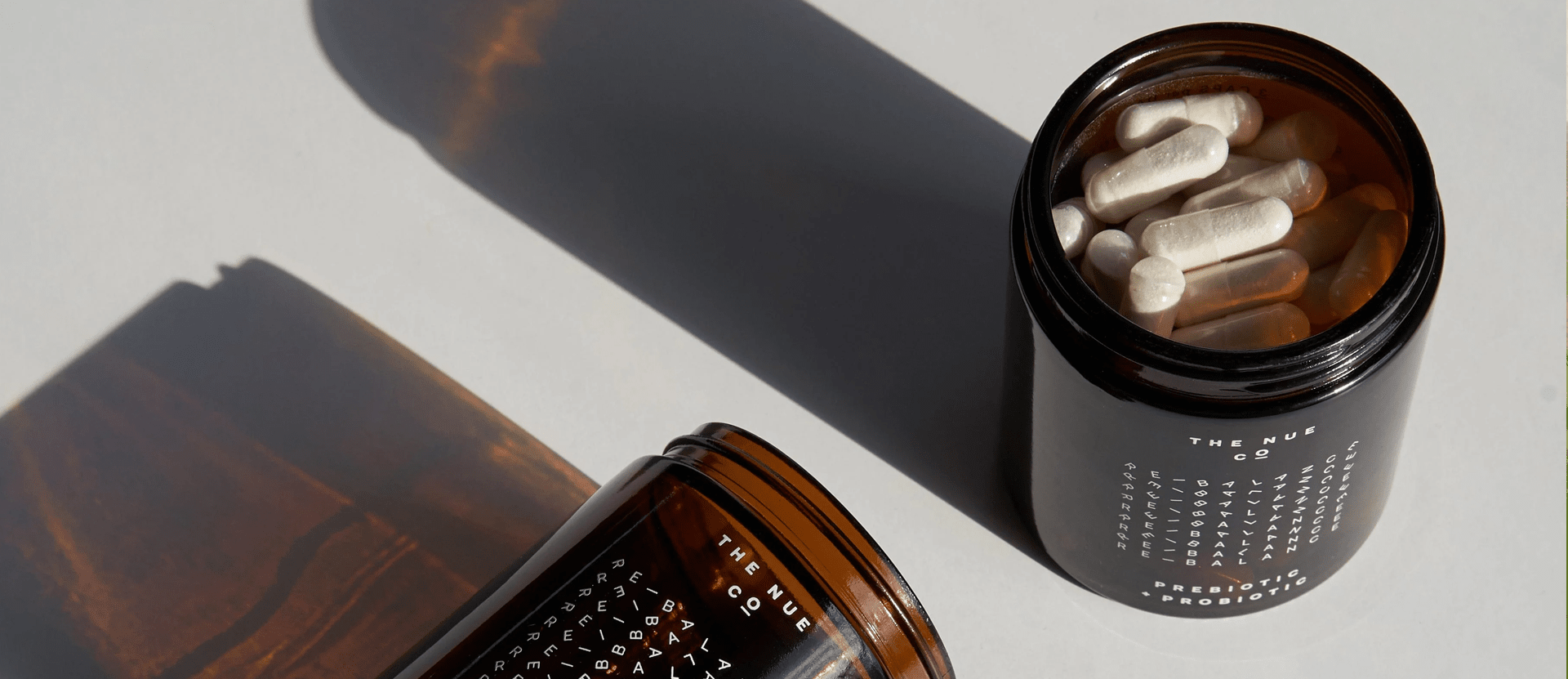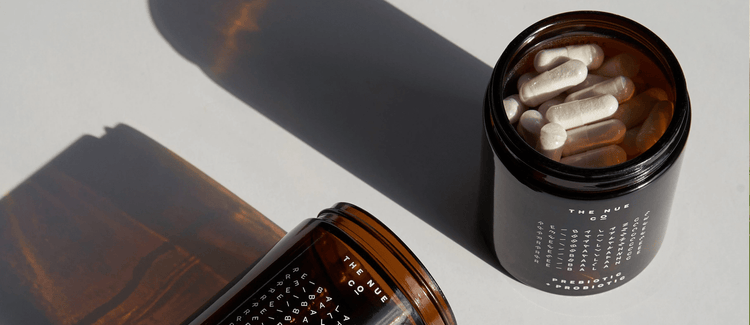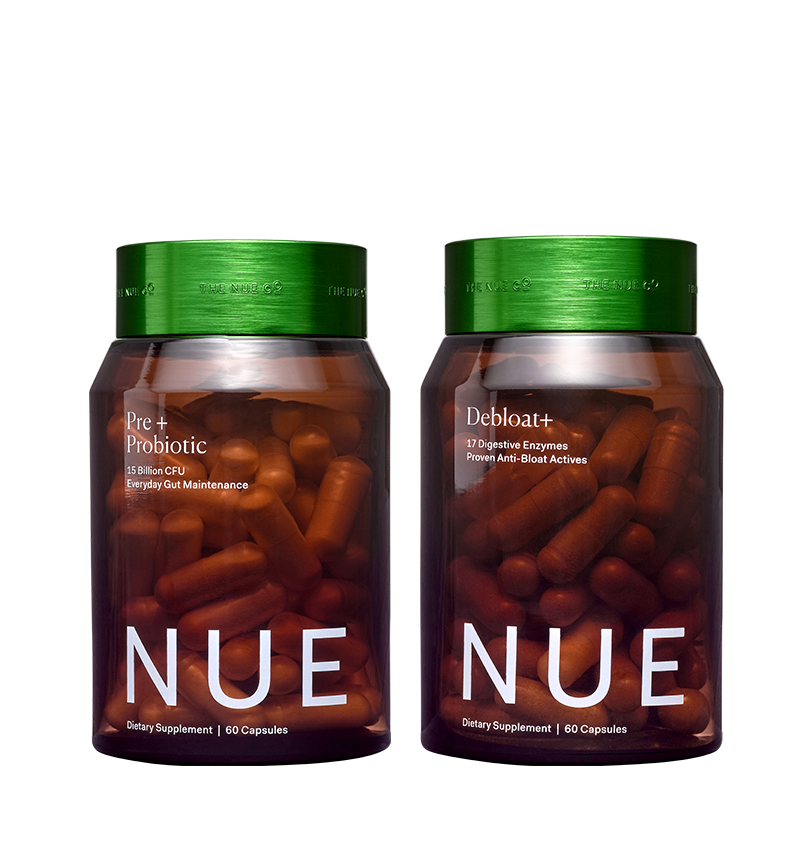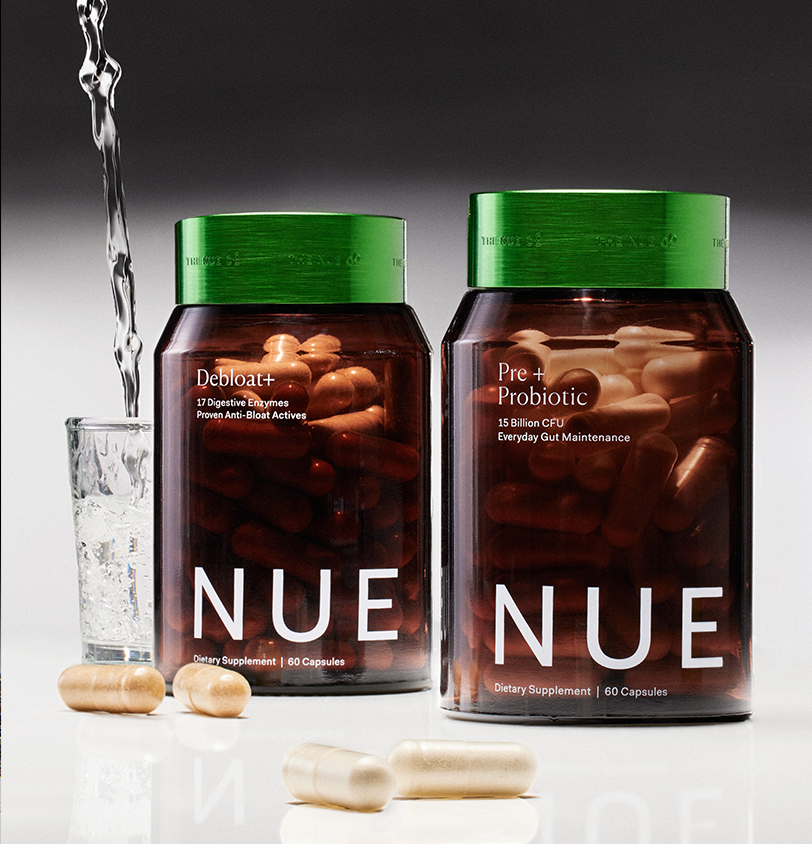Prebiotics vs. Probiotics
Everything you’ve ever wanted to know about prebiotics and probiotics.


Prebiotics, probiotics, synbiotics, and postbiotics: four essential parts of gut health, with the first two being essential parts of a healthy gut microbiome as they work to balance bacteria levels.
What are probiotics?
Probiotics are types of live microorganisms that are known to be beneficial to our bodies. They contain bacteria, which is a type of microorganism, but unlike the bacteria that causes you to get a cold when encountering germs on public transport, they are known as the “good” bacteria––by which we mean that they benefit your health.
The study of probiotics was first conducted by Elie Metchnikoff, a Nobel-prize winning Russian microbiologist who worked at the Pasteur Institute in Paris with Luis Pasteur. In 1910, Metchnikoff started to think about the potential benefits of fermented foods to combat certain gut bacteria which was known to produce toxic substances. He discovered that some of the long-living communities in the world regularly ate fermented food, and that Georgians in particular ate copious amounts of sour milk, even having a popular slogan which stated “If you want to live long, drink more sour milk.” Based on his research, Metchnikoff concluded that the consumption of fermented foods would supply the gut with beneficial bacteria which could work to balance out the pathogenic, harmful bacteria.
Since probiotics are living organisms, they are found in foods with live cultures or ones that are fermented, such as kimchi, yogurt, sauerkraut, kombucha, and miso. The most common bacteria in probiotics are Lactobacillus and Bifidobacterium, or Saccharomyces boulardii, which is yeast-based.
Within each type of bacteria, there are different strains, meaning that each type of probiotic can be further classified and identified by the benefits it provides. So while some strains may help with digestion, others may work to improve immunity or weight management.
When you see a probiotic listed as an ingredient on a label, you’ll likely see a very long phrase like this: "Bifidobacterium lactis UBLa-12." The three sections of the phrase, in order, directly correspond to the genus, species and strain.
What are prebiotics?
A good way to understand the distinction between the two is to think of the gut as a garden. If the probiotics are the plants and flowers, then the prebiotics function as fertilizer, providing the probiotics with an essential food base that allows them to grow and thrive.
Prebiotics are technically fibers that resist digestion both when passing through the stomach and small intestine, arriving successfully to the colon. Once they reach the colon, they are fermented by probiotic bacteria and broken down into short-chain fatty acids such as butyrate, acetate and propionate. From there, they are used successfully as fuel for probiotics in the microbiome, ensuring their growth.
Prebiotics were first officially defined in 1995 by Dr. Gibson, a professor of microbiology, and Dr. Marcel Roberfroid. The official prebiotic definition describes a prebiotic as “a non digestible food ingredient that beneficially affects the host by selectively stimulating the growth and/or activity of one or a limited number of bacteria in the colon, and thus improves host health.”
They can be found in foods such as bananas, apples, oats, flaxseed, wheat bran, seaweed and even barley, but many are familiar with one of their other forms: inulin. Inulin is a soluble fiber found in plants including chicory root, asparagus, garlic, leeks, and Jerusalem artichokes, but because of the way they are used commercially, cause hesitation in many. Commercial inulin is highly processed and used as a bulking device in pre-packed foods that can cause digestive issues in many, especially those who have IBS. However, when inulin is used in smaller doses for prebiotic use from sources like organic chicory and Jerusalem artichoke, it can be extremely beneficial for gut health as it isn’t being used as a source of fiber.
What are synbiotics and postbiotics?
To put it simply, synbiotics are combinations of prebiotics and probiotics that work together synergistically to benefit the host––hence the name “synbiotic.” Postbiotics, on the other hand, are “non-viable bacterial products” from “probiotic microorganisms that have biologic activity in the host.” In simple terms, it means they are compounds that are created after probiotic fibers are broken down, which can then provide a host of benefits.
Benefits
Because there are so many different types of probiotics, the benefits of probiotics vary depending on the genus and strain. However, some benefits are more common than others, and can be expected from a broad group of probiotics and prebiotics.
Immunity
The relationship between probiotics and the immune system is perhaps the most well-known of the probiotic benefits, going back as far as Metchnikoff's original hypotheses. In fact, 70% of your immune system actually is located in your intestine. The science of it, however, is a little more detailed.
If we return to the garden analogy, it can help to understand how the gut bacteria works in terms of immunity. Consider a well-tended garden. It’s properly watered, with an array of selected flowers, plants, and herbs that have been planted and fertilized with certain soil to help it grow. If that same garden is left unattended, however, you risk the chance of weeds coming in and overwhelming the space, meaning that they grow instead of the plants you wanted.
Like a garden, your gut has a certain amount of space for bacteria, and that bacteria needs to be kept in a positive balance, with the “good” bacteria outweighing the bad. This is where probiotics come in. When they are ingested and reach the gut, they are able to crowd out the negative, pathogen-causing ones (that could lead to illness and disease), so they are unable to multiply and thrive––keeping your immune system healthy and functional.
Digestive system: IBS, flatulence and trapped wind
Just like with immunity, it’s all about the microbiota balance when it comes to digestive support. When our gut flora is out of whack, we tend to experience symptoms such as bloating, diarrhea or constipation, flatulence (that can sometimes be smelly gas), trapped wind and abdominal pain. These are all signs that the pathogenic-causing bacteria in your gut have outnumbered the good. Because these are all symptoms of IBS, probiotics can play a huge role in providing relief.
Though foods such as yogurt and kefir may help alleviate some of the symptoms, when it comes to rebalancing the gut, it’s best to go to the source and directly supply the microbiota with a healthy dose of probiotics. The probiotics in our PREBIOTIC + PROBIOTIC supplement, Bacillus Coagulans, or LactoSpore®, have been clinically proven to improve symptoms of IBS such as diarrhea, bloating and abdominal pain within 90 days.
Anxiety and depression
One of the most significant areas of research in terms of gut health in recent years has been on the gut-brain axis, or the direct connection between our gut health and cognition. It’s been theorized that changes in intestinal bacteria may play a significant role in anxiety and depression, as intestine actually has its own separate nervous system and even generates some of the same neurotransmitters as the brain such as serotonin.
It has also been thought that it works in the opposite direction, where increased anxiety and stress could cause digestive disorders due to high levels of cortisol production and the generation of additional pathogen-causing bacteria.
How we use them
At The Nue Co., we believe that everything starts with a healthy gut, and so try to incorporate prebiotics and probiotics into products whenever possible. Here are our go-to products, and how we incorporate prebiotics, probiotics, or both:
PREBIOTIC + PROBIOTIC
Our bestselling digestive health formula, in an easy-to-take daily capsule. The supplement is made with probiotic spores as opposed to live strains to ensure that the full dose survives the trip through your stomach. Upon reaching the intestine, the probiotics are able to feed off the prebiotics included, which come from inulin that’s sourced from organic chicory. Together, the two work to alleviate symptoms of IBS such as stomach pain, bloating, diarrhea and constipation.
DEBLOAT FOOD + PREBIOTIC
This powder that mixes right in with oatmeal, smoothies, or even just milk for a delicious way to help reduce the symptoms associated with IBS and other digestive issues. The formula includes prebiotic inulin, which is sourced from organic artichokes, to help act as a fertilizer for the good bacteria in your gut in addition to reducing gas. There are no probiotics in this formula, but it does contain natural carminatives such as cinnamon, ginger and turmeric to ease gut discomfort.
PROBIOTIC PROTEIN - PLANT
Protein makes up everything in our bodies from hair and skin to joints and muscles, but it can be difficult to get enough of it on a vegan diet. This 100% vegan protein powder is a complete protein, meaning that it has all nine amino acids that the body is unable to produce on its own. Its complete status comes from a blend of three vegan proteins––organic pea, hemp, and brown rice––and is unflavored and unsweetened. We’ve also added probiotic Bacillus Coagulans and prebiotic inulin to make this more than just a protein powder –– its a protein powder that helps keep your gut healthy and functional.
PROBIOTIC PROTEIN - MILK
The non-vegan alternative to our plant protein, PROBIOTIC PROTEIN is a whey protein that’s sourced from grass-fed cows. Whey is the byproduct of the process of turning milk into cheese and is a complete protein on its own. The daily protein powder is fortified with Bacillus Coagulans and prebiotic inulin. Bacillus coagulans is sporulated as opposed to a live strain, meaning that it is shelf stable (so you don’t have to refrigerate your protein powder), and to ensure that it survives the trip through your stomach to arrive at your gut.
So what should I take?
When it comes to choosing, it’s important to note that it isn’t prebiotics vs. probiotics, but that they are separate entities that work symbiotically and aren’t interchangeable. If you decide that you want to try and take probiotics, then taking a prebiotic as well will only help the probiotic’s bioavailability, or how well it is able to work in your body. On their own, prebiotics have been known to support gut health, as one study, conducted in 2017, found that inulin derived from chicory reduced gas by 22% and increased the levels of good bacteria in the gut. However, their benefits are really seen when working with probiotics, which is why we’ve paired them in our daily PREBIOTIC + PROBIOTIC supplement. Try it see what a difference it can make for yourself.
Reference list
Athos Bousvaros, MD (2017). Can probiotics help treat depression and anxiety? - Harvard Health Blog. [online] Harvard Health Blog. Available at: https://www.health.harvard.edu/blog/can-probiotics-help-treat-depression-anxiety-2017072612085 [Accessed 6 Jan. 2020].
Azpiroz, F., Molne, L., Mendez, S., Nieto, A., Manichanh, C., Mego, M., Accarino, A., Santos, J., Sailer, M., Theis, S. and Guarner, F. (2017). Effect of Chicory-derived Inulin on Abdominal Sensations and Bowel Motor Function. Journal of Clinical Gastroenterology, [online] 51(7), pp.619–625. Available at: https://www.ncbi.nlm.nih.gov/pmc/articles/PMC5499961/ [Accessed 6 Jan. 2020].
Hutkins, R.W., Krumbeck, J.A., Bindels, L.B., Cani, P.D., Fahey, G., Goh, Y.J., Hamaker, B., Martens, E.C., Mills, D.A., Rastal, R.A., Vaughan, E. and Sanders, M.E. (2016). Prebiotics: why definitions matter. Current Opinion in Biotechnology, [online] 37, pp.1–7. Available at: https://www.ncbi.nlm.nih.gov/pmc/articles/PMC4744122/?fbclid=IwAR25muDHqqp4Zs6e9wEgLXpqDAVMTrcOiVIghFGbu_l88uS66Gt3ugqJ9y0.
Mackowiak, P.A. (2013). Recycling Metchnikoff: Probiotics, the Intestinal Microbiome and the Quest for Long Life. Frontiers in Public Health, [online] 1. Available at: https://www.ncbi.nlm.nih.gov/pmc/articles/PMC3859987/.
NCCIH. (2012). Probiotics: What You Need To Know | NCCIH. [online] Available at: https://nccih.nih.gov/health/probiotics/introduction.htm#hed1.
Organic, O. (2019). Probiotics for Immunity: How do Probiotics Help the Immune System? [online] Ora Organic. Available at: https://www.ora.organic/blogs/news/probiotics-for-immunity-how-do-probiotics-help-the-immune-system [Accessed 6 Jan. 2020].
Patel, R.M. and Denning, P.W. (2013). Therapeutic Use of Prebiotics, Probiotics, and Postbiotics to Prevent Necrotizing Enterocolitis. Clinics in Perinatology, [online] 40(1), pp.11–25. Available at: https://www.ncbi.nlm.nih.gov/pmc/articles/PMC3575601/ [Accessed 12 Dec. 2019].
Pierce, K. (2016). Probiotics for a Long and Healthy Life. [online] Available at: http://hardydiagnostics.com/wp-content/uploads/2016/05/Metchnikoff-and-Probiotics-Kerry-Pierce.pdf [Accessed 6 Jan. 2020].
ThemeGrill (2019). What Are Prebiotics? [online] Illinois.edu. Available at: https://hdh.fshn.illinois.edu/2019/06/12/what-are-prebiotics/ [Accessed 6 Jan. 2020].
---
Originally written by Halley Furlong-Mitchell and edited by Lara Spiller

